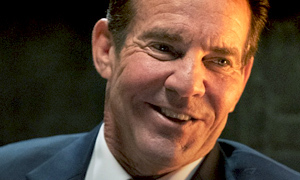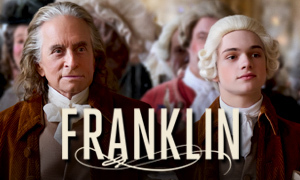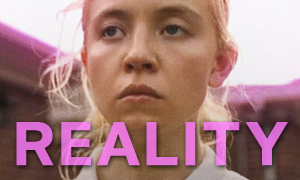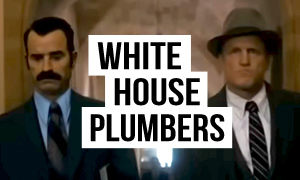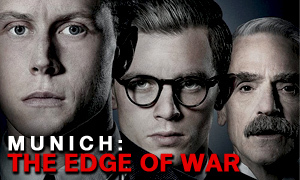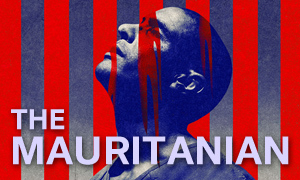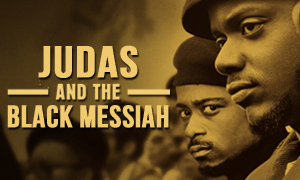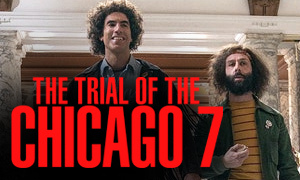The Crown: History vs. Hollywood
| REEL FACE: | REAL FACE: |
Claire Foy
Born: April 16, 1984 Birthplace: Stockport, England, UK | Queen Elizabeth II
Born: April 21, 1926 Birthplace: 17 Bruton Street, Mayfair, London, England, UK |
Matt Smith
Born: October 28, 1982 Birthplace: Northampton, Northamptonshire, England, UK | Prince Philip
Born: June 10, 1921 Birthplace: Mon Repos, Corfu, Kingdom of Greece |
John Lithgow
Born: October 19, 1945 Birthplace: Rochester, New York, USA | Winston Churchill
Born: November 30, 1874 Birthplace: Woodstock, England, UK Death: January 24, 1965, London, England, UK (stroke) |
Harriet Walter
Born: September 24, 1950 Birthplace: London, England, UK | Clementine Churchill
Born: April 1, 1885 Birthplace: Mayfair, London, England, UK Death: December 12, 1977, Knightsbridge, London, England, UK |
Vanessa Kirby
Born: April 18, 1988 Birthplace: Wimbledon, London, England, UK | Princess Margaret
Born: August 21, 1930 Birthplace: Glamis Castle, Scotland, UK Death: February 9, 2002, King Edward VII Hospital, London, England, UK (stroke) |
Ben Miles
Born: 1967 Birthplace: Wimbledon, London, England, UK | Peter Townsend
Born: November 22, 1914 Birthplace: Rangoon, Burma Death: June 19, 1995, Saint-Leger-en-Yvelines, France |
Jared Harris
Born: August 24, 1961 Birthplace: London, England, UK | King George VI
Born: December 14, 1895 Birthplace: York Cottage, Sandringham House, Norfolk, UK Death: February 6, 1952, Sandringham House, Norfolk, UK (lung cancer) |
Victoria Hamilton
Born: April 5, 1971 Birthplace: Wimbledon, South London, England, UK | Queen Elizabeth The Queen Mother
Born: August 4, 1900 Birthplace: London, England, UK Death: March 30, 2002, Royal Lodge, Windsor, Berkshire, UK (cold/chest infection) |
Eileen Atkins
Born: June 16, 1934 Birthplace: Clapton, London, England, UK | Queen Mary
Born: May 26, 1867 Birthplace: Kensington Palace, London, England, UK Death: March 24, 1953, Marlborough House, London, England, UK (lung cancer) |
Alex Jennings
Born: May 10, 1957 Birthplace: Essex, England, UK | Duke of Windsor
Born: June 23, 1894 Birthplace: White Lodge, Richmond, Surrey, England, UK Death: May 28, 1972, 4 Route du Champ d'Entraînement, Paris, France |
Lia Williams
Born: November 26, 1964 Birthplace: Birkenhead, Merseyside, England, UK | Duchess of Windsor (aka Wallis Simpson)
Born: June 19, 1896 Birthplace: Blue Ridge Summit, Pennsylvania, USA Death: April 24, 1986, 4 Route du Champ d'Entraînement, Paris |
Greg Wise
Born: May 15, 1966 Birthplace: Newcastle, England, UK | Lord Mountbatten
Born: June 25, 1900 Birthplace: Frogmore House, Windsor, Berkshire, England, UK Death: August 27, 1979, Mullaghmore, County Sligo, Ireland (assassination by IRA bomb) |
Pip Torrens
Born: June 2, 1960 Birthplace: Bromley, Kent, England, UK | Tommy Lascelles
Born: April 11, 1887 Birthplace: UK Death: August 10, 1981, Kensington Palace, London, England, UK |
Harry Hadden-Paton
Born: April 10, 1981 Birthplace: London, England, UK | Martin Charteris
Born: September 7, 1913 Death: December 23, 1999 |
Jeremy Northam
Born: December 1, 1961 Birthplace: Cambridge, Cambridgeshire, England, UK | Anthony Eden
Born: June 12, 1897 Birthplace: Windlestone Hall, Rushyford, County Durham, England, UK Death: January 14, 1977, Alvediston, Salisbury, Wiltshire, England, UK (liver cancer) |
Stephen Dillane
Born: March 27, 1957 Birthplace: London, England, UK | Graham Sutherland
Born: August 24, 1903 Birthplace: Streatham, London, England, UK Death: February 17, 1980, Kent, England, UK |
Nicholas Rowe
Born: November 22, 1966 Birthplace: Edinburgh, Scotland, UK | Jock Colville
Born: January 28, 1915 Birthplace: UK Death: November 19, 1987, UK |
Joseph Kloska
Birthplace: North Cornwall, England, UK | Lord 'Porchey' Porchester
Born: January 19, 1924 Birthplace: Lancaster Gate, London, England, UK Death: September 11, 2001, UK (heart attack) |
How did Queen Elizabeth and Prince Philip meet?
The Crown true story reveals that Philip's uncle, Lord Mountbatten, arranged the first meeting between Philip and Elizabeth in 1939 when the Royal Family toured the Royal Naval College. The exiled Prince Philip of Greece and Denmark was 18 and serving in the British Royal Navy. Elizabeth was 13-years-old and became smitten with the older Philip, who in turn took an immediate liking to Elizabeth. The pair began writing letters to each other and continued their correspondence throughout the Second World War. Philip was of royal blood and was distantly related to Elizabeth. They were third cousins through Queen Victoria and second cousins once removed by way of King Christian IX of Denmark. Both Philip's mother and grandmother were born at Windsor Castle. Philip proposed to Elizabeth in 1946 and they were married on November 20, 1947. See footage of Elizabeth and Philip's wedding day.
Did Elizabeth really get married in a dress bought with clothing coupons?
Yes. In 1947, Britain was still recovering from World War II and was in a period of economic austerity. Designed by Norman Hartnell, Elizabeth's ivory satin gown was adorned with 10,000 white pearls. While fact-checking The Crown, we discovered that Elizabeth had collected clothing coupons to use to obtain the fabric for the gown. Women across the country sent their own coupons to her as well, but she tactfully returned them, not wanting to take from those who might need them more. -GQ
Did King George VI really like to tell vulgar limericks?
Not that we're aware of, but he was known to occasionally use coarse language and lose his temper, traits that were also depicted in the 2010 Colin Firth film The King's Speech. On the Netflix show, King George VI (Jared Harris) gets frustrated as his valet struggles to adjust his collar. To calm him down, his equerry, Peter Townsend, shares a dirty limerick and then King George shares one of his own. The limerick told by George on the show was made up by director Stephen Daldry and the production team. -Mashable.com
Did King George VI really have a lung operation in the Palace rather than a hospital?
Yes. In researching The Crown true story, we learned that in 1951, they really operated to remove part of King George's lung under the chandeliers of Buckingham Palace and not in a hospital. Crowds gathered outside awaiting news on his condition following the surgery. Heavy smoking had contributed to the development of lung cancer. -TIME.com
Had the Queen really been a mechanic during the war?
Yes, on Netflix's The Crown TV show, Elizabeth helps fix their broken-down automobile in Kenya and refers to being a mechanic in the military during World War II. In exploring the true story, we learned that this is indeed factual. She was a member of the Auxiliary Territorial Service and trained as a military truck driver and mechanic (watch footage of Elizabeth driving and working on a military truck). In addition, she is the only female in the Royal Family to have ever served in the armed forces. -GQ
Did Princess Elizabeth really learn of her father's death while writing a letter to him in Kenya?
Yes. The true story behind Netflix's The Crown confirms that this was indeed how Princess Elizabeth learned of her father's February 6, 1952 death. She and Philip had been on a tour of Australia via Kenya. Like on the show, they had just returned to the Sagana Lodge after a night spent at Treetops Hotel in Aberdare National Park in Kenya. Philip broke the news to her while she was in the middle of writing a letter to her father, King George VI, whose death marked Elizabeth's immediate accession to the throne. At only 25 years of age, she returned home the Queen. Her coronation was held the following year on June 2, 1953, more out of respect for her father's passing than any ploy by an aging Prime Minister Winston Churchill to secure more time in office. -TIME.com
Did Philip really make a fuss about having to kneel in front of his Queen at her coronation?
Not likely. With regard to the tense scene, expert Christopher Wilson told the Daily Mail, "I doubt Prince Philip ever spoke those words to his wife, because he came from a royal house which had borrowed so much of its ritual and protocol from the British Royal Family. He knew full well what was expected of him in public, and was prepared to go along with it." What unfolds on The Crown TV show is completely unproven. One thing that is based in truth is that the Queen's coronation was the first to be aired on television. Watch Queen Elizabeth II's coronation.
Did Princess Margaret really have an affair with Peter Townsend?
Yes. Group Captain Peter Townsend was a British Royal Air Force officer who became Equerry to King George VI and then to his daughter Queen Elizabeth II from 1952 to 1953. Like on Netflix's The Crown TV show, he fell in love with Princess Margaret, 15 years his junior, and divorced his wife after Margaret's sister Elizabeth became Queen. He proposed to a 22-year-old Margaret the following year, but the Parliament and the Church of England refused to approve a union with a divorced man. Similar to her uncle, she was given the option of giving up her royal titles and income, a price she was not willing to pay.
"She could have married me only if she had been prepared to give up everything—her position, her prestige, her privy purse," Townsend wrote in his 1978 autobiography Time and Chance. "I simply hadn't the weight, I knew it, to counterbalance all she would have lost."
Margaret eventually ended the romance in 1955 and she later became engaged to Antony Armstrong-Jones shortly after learning of Townsend's own engagement to Marie-Luce Jamagne (which some say was a sign Margaret was not over Townsend). Armstrong-Jones was a photographer who the Queen made the Earl of Snowdon. Margaret's turbulent marriage to Armstrong-Jones would end in a scandalous divorce in 1978. -VanityFair.com
Did Queen Elizabeth II have a tense relationship with Winston Churchill?
No. Winston Churchill seems to be one of the more misrepresented characters on the show. In real life, he was less uptight, more jovial, and adored by the people. His relationship with Elizabeth was not fraught with tension like it is for much of the first season of The Crown. Instead, Elizabeth and Winston had a famously good relationship. In later years, she was asked which Prime Minister was her favorite. Her reply, "Winston of course, because it was always such fun." Churchill had also been close friends with Elizabeth's parents and had a strong working relationship with them as well. One can only guess why the filmmakers chose to largely reinvent Churchill and portray him in a somewhat negative light.
Does The Crown present King Edward VIII's abdication accurately?
Not exactly. For the most part, it focuses on only one side of the story, the Duke of Windsor (formerly King Edward VIII) abandoning the throne so he can marry the twice-divorced American Wallis Simpson. It fails to mention that King Edward VIII was actually adored by the people, especially the poor, and it was the monarchy and Parliament who wanted to oust the often hard-to-control king, a monarch with an apparent disregard for longstanding constitutional conventions. Edward's desire to marry Simpson provided them with a way to get rid of him. This King Edward VIII documentary reveals more about what it refers to as a "British coup."
The Netflix series begins after the abdication and also fails to mention that Edward had been in a relationship with Wallis Simpson for five years before he started his brief 326-day stint on the throne (the shortest in British history), which began with the passing of his father, King George V, on January 20, 1936. While some in the country stood behind Edward's choice to leave the throne for love, he had been previously known for his affairs with married women, and his father, King George V, had told others that he prayed Edward's younger brother Albert (George VI) and granddaughter Elizabeth would eventually inherit the throne (ironically, Elizabeth went on to become the longest reigning monarch in British history).
Did the Duke and Duchess of Windsor really have nicknames for the Royal Family?
Yes. When King Edward VIII abdicated the throne on December 11, 1936 so he could marry the twice-divorced American Wallis Simpson, it certainly created a rift with the Royal Family. Edward and Wallis (the Duke and Duchess of Windsor) indeed had a handful of nicknames for them. In letters published in 1988, they called the Queen Mother "Cookie" or "the Scottish Cook" and the Queen "Shirley Temple." They referred to Winston Churchill as "Cry Baby." Upon learning that his personal allowance was being cut off after the death of his brother, George VI, he called Queen Mary and the two Elizabeths "ice-veined bitches." When he returned to England again in 1953 after his mother, Queen Mary, died, he wrote to his wife and highlighted his bitter relationship with the Royal Family. "What a smug, stinking lot my relations are and you've never seen such a seedy worn out bunch of old hags most of them have become."
Did Queen Elizabeth II really take advice from her uncle, the former King Edward VIII?
No, this is not based in fact. In Netflix's The Crown series, the Queen seeks advice on aspects of her reign from her uncle, the Duke of Windsor (formerly King Edward VIII), who had abdicated the throne to marry American socialite Wallis Simpson, thrusting the Queen's father, King George VI, into a role he never wanted. The scene between the Queen and her uncle is fictional. "It's unlikely that the Queen would have turned to the former King Edward VIII for counsel on her role as monarch," says royal historian Carolyn Harris. -Mashable.com
Did Winston Churchill have his secretaries read him his papers through the door while taking a bath?
Yes, during our investigation into The Crown true story, we confirmed that Prime Minister Churchill indeed did this, though the scene where he carelessly causes a wave of water to pour out of the tub and under the bathroom door is likely fiction. -Royal Central
Was Winston Churchill's assistant Venetia Scott really killed by a bus?
No. The Crown will have you believe that Churchill's eager assistant Venetia Scott (Kate Phillips) was struck by a bus, prompting him to change his position on the Great Smog of 1952 and come to London's rescue. According to the Radio Times, the show's starstruck secretary who memorized Churchill's autobiography is pure fiction. Venetia Scott never existed in real life.
Was the Great Smog a real event in London?
Yes, fact-checking The Crown confirms that the Great Smog was indeed a real event in 1952. An anticyclone combined with a period of cold weather and windless conditions to create a thick blanket of dense smog that enveloped London for several days from Friday, December 5 until Tuesday, December 9. An estimated 3,500 - 4,000 people died as a direct result of the smog and hospitals had trouble keeping up. Research conducted later suggests that the long-term effects of the smog led to a considerably greater number of fatalities, totaling between 6,000 and 12,000.
Though the event was devastating, Netflix's The Crown TV show turns it into more of a political crisis than it actually was in real life. In reality, it was tragic but not nearly as dramatic. It did not cause outright panic. This was partially due to the fact that Londoners were used to poor air quality and had experienced "fogs" in the past, albeit they were shorter and less dense. In addition, the long-term consequences of the Great Smog weren't recognized until weeks and even years later. -People.com
Was Philip really upset over his children not getting his chosen last name?
Yes. Courtiers and government officials advised Elizabeth against having her children take Philip's chosen last name of Mountbatten since they were worried that it would award the Mountbatten family stature over the Windsors. Like on the show, Philip balked, "I am the only man in the country not allowed to give his name to his own children." Philip's uncle, Lord Mountbatten, did wield considerable influence over him. Philip had lived with the Mountbatten family since he was seven (his mother had been diagnosed with schizophrenia and sent to an asylum, and his father, Prince Andrew of Greece and Denmark, abandoned the family and moved to Monte Carlo after being exiled from Greece). Despite announcing in 1952 that her children would use the last name Windsor (as she does on the show), in a 1958 move made under the radar, she changed the name to "Mountbatten-Windsor." It is believed this was done to resolve a point of contention for Philip. -People.com
Was Queen Elizabeth close friends with Porchey?
Yes, Porchey, aka Lord Porchester (born Henry Herbert), was a childhood friend of Queen Elizabeth. The two were very close in real life too, and the Queen welcomed him as her horse racing manager in 1969. Some speculated that the two had an affair and even that Porchey is Prince Andrew's real father, but no evidence of an actual romance exists and that rumor has been called 'fraudulent' by historians. Also, Elizabeth's confrontation with Philip regarding his jealousy of Porchey (where she also accuses him of loving other women) is pure invention. Of course, it is believable that Philip could have resented a platonic friendship between his wife and Porchey, but if so, those feelings were never made public. Like on the show, Lord Porchester (later the Earl of Carnarvon) eventually married Anglo-American Jean Margaret Wallop, with whom he had three children. He also eventually became the owner of the Downton Abbey backdrop Highclere Castle. -People.com
Did Elizabeth and Philip endure the marital strains depicted on the show?
For the most part, no, at least not according to historians, who say there has never been any evidence that the marriage was ever under the hardships seen on the Netflix drama. This includes Philips roving eye and Elizabeth's near-inappropriate friendship with Porchey. "I have never come across anything which suggested the marriage was under any real strain at any point," says royal biographer Philip Ziegler. "The Queen's friendship with Lord Porchester was a platonic and personal one. They were both passionate about horses." One flare-up from the show that was based in fact was when a furious Queen threw a tennis racket at Prince Philip as he fled an Australian chalet where they were staying in 1954. -Daily Mail Online
Did Philip really struggle after Elizabeth became Queen?
Yes. In addition to Elizabeth not taking his name, Mountbatten, Prince Philip made the sacrifice of giving up his naval career once Elizabeth became Queen. He played second fiddle to her despite having more royal blood than Elizabeth herself. The palace courtiers attempted to curtail his modern ways and froze him out of the Queen's matters. In the early days, he went out drinking at places like the infamous Thursday Club in Soho, an exclusive male gathering spot for the well-to-do. His shenanigans there were noticed and seemed to be his way of escaping the difficulties of his new life as husband to the Queen of England. -The Guardian
Did the Queen ask her favorite Private Secretary, Martin Charteris, to take over when Tommy Lascelles stepped down?
It is unknown whether this is true or not. On the TV show, the Queen (Claire Foy) tries to promote Martin Charteris (Harry Hadden-Paton) to be her Private Secretary instead of Michael Adeane, who was next in line for the job. What we do know is that Charteris was the Queen's favorite Private Secretary, and according to former royal correspondent Jennie Bond, Charteris told her that the Queen wanted him from the beginning. The Queen backs down on the show and accepts Adeane after Tommy Lascelles warns her not to deviate from the established way of doing things. In real life, it took another 20 years before Martin Charteris would advance to become her Private Secretary, a position he held from 1972 until his retirement in 1977. Though it's not emphasized on the show, prior to his 1972 appointment, he was the Assistant Private Secretary alongside Adean and Edward Ford. -RadioTimes.com
Did a grieving Queen Mother really flee to Scotland right after the 1953 London unveiling of a statue for her late husband?
No. In real life, the Queen Mother's trip to Scotland occurred in 1952 and the statue of King George VI wasn't unveiled until 1955. The show's creators manipulated the timeline to add more drama. -Macleans.ca
Did Churchill's wife really burn the painting?
For the most part, this is true. Winston Churchill and his wife Clementine indeed hated Graham Sutherland's 1954 full-length portrait, which was presented to Churchill at Westminster Hall on his 80th birthday, November 30, 1954. His wife had viewed the completed portrait prior to the unveiling. Unlike on the show, she took a photograph of it back to her husband. He tried to reject it before the ceremony but was urged to go ahead with the unveiling, so as to not upset the donors who paid for it. During the presentation, Churchill wryly commented, as John Lithgow's character does, that it was "a remarkable example of modern art." Naturally, Churchill's critics liked the portrait while his colleagues condemned it as a disgusting insult.
Afterward, he took it back to Chartwell where it was never displayed and was hidden away in the cellar, that is until Clementine asked her secretary, Grace Hamblin, to get rid of it. Due to its weight, Hamblin asked her brother ("a landscape gardener or something") to help her sneak it off the property during the night. They put it in her brother's van and drove it to his house a few miles away. According to Hamblin, they built a huge bonfire around back and then burned the portrait of Winston Churchill where no one could see. -VanityFair.com
Was the Royal Household involved in the making of The Crown?
No. The royal press office released the following statement: "The Crown is a fictional drama. The Royal Household has had no involvement." The scenes that happen behind closed doors and out of the public eye are fictional and mostly speculative, as the Queen and Prince Philip are well known for their ability to keep their private lives private and their opinions neutral when in public. -Bustle.com
Queen Elizabeth II Coronation, Speeches & Documentaries
Further peer into The Crown true story by watching the documentaries, news reels and speeches below, including Queen Elizabeth II's first televised Christmas speech and a King Edward VIII abdication documentary, which concludes he was just as much ousted as king as resigned.
Link-to-Learn More:
